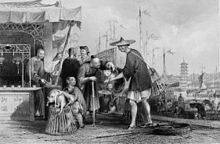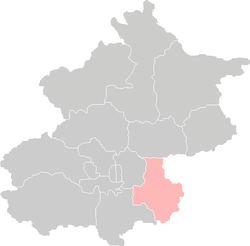|
Tongzhou, Beijing
Tongzhou[a] is a district of Beijing. It is located in southeast Beijing and considered the eastern gateway to the nation's capital. Downtown Tongzhou itself lies around 20 km (12 mi) east of central Beijing, at the northern end of the Grand Canal (on the junction between the Tonghui Canal and the Northern Canal) and at the easternmost end of Chang'an Avenue. The entire district covers an area of 906 km2 (350 sq mi), or 6% of Beijing's total area. It had a population of 673,952 at the 2000 Census, and has seen significant growth and development since then, growing to a population of 1,184,000 at the 2010 Census and 1,840,295 at the 2020 census.[1] The district is subdivided into four subdistricts, ten towns, and one ethnic township. History Tongzhou was founded in 195 BC during the Western Han dynasty under the name of Lu (路) County, although there is evidence for human settlement in the Neolithic. At the start of the Eastern Han dynasty the character Lu by which it was known was altered by the addition of a water radical to become Lu (潞). In 1151 under the Jin dynasty Lu County was renamed Tongzhou, roughly meaning 'the place for passing through', in recognition of its importance as the land and water approach to Beijing. Ming, Qing & Republican eraIn July 1937, subsequent to the infamous Marco Polo Bridge Incident, Tongzhou became another site of determined Chinese resistance. In the Tongzhou mutiny troops of the nominally Japanese-puppet East Hebei Army rebelled and came to the aid of hard-pressed Kuomintang troops, and attacked the Japanese garrison. In the fall of Tongzhou to the Nationalists, many civilians were tortured and murdered as well as captured Japanese military personnel. People's RepublicThe place name changed to Tong County (simplified Chinese: 通县; traditional Chinese: 通縣; pinyin: Tōng Xiàn) when the area was placed under the new municipal region of Beijing in 1914. It again reverted to "Tongzhou" when the area was upgraded in 1997 to a district.[2] On 11 July 2015, Tongzhou became the second administrative seat of Beijing as a "sub-administrative center" for the municipality.[3] Numerous local government departments will be moved to Tongzhou to reduce crowding within the city center of Beijing.[4] EconomyIn 2017, the regional GDP of the district was 75.8 billion yuan,[5] with GDP per capita at 50.3 thousand yuan. Geography and environment Tongzhou District borders the Beijing districts of Shunyi, Chaoyang and Daxing, Wuqing District of Tianjin Municipality, and Langfang City (both the Sanhe City−Dachang County−Xianghe County exclave and Guangyang District) of Hebei province, and is 12 miles from Tiananmen Square and 10 miles from Beijing Capital International Airport. Tongzhou is situated on the North China Plain with an average elevation of 20 meters (66 ft). Its climate belongs to the mild temperate zone, with distinct seasons including hot summers and freezing winters. Dust storms are common. It has an annual mean temperature of 11.3 °C (52.3 °F). and 620 mm (24 in) of rainfall. Several large rivers, among them the Wenyu, the Liangshui and Chaobai flow through the district. ClimateTongzhou District has a humid continental climate (Köppen climate classification Dwa). The average annual temperature in Tongzhou is 13.2 °C (55.8 °F). The average annual rainfall is 536.6 mm (21.13 in) with July as the wettest month. The temperatures are highest on average in July, at around 27.0 °C (80.6 °F), and lowest in January, at around −2.7 °C (27.1 °F).
Administrative divisionsTongzhou District is divided into six subdistricts, ten towns, and one ethnic township. Two of the towns of which carry the "area" (地区) label.[9][10] 
On May 11, 2020, Tongzhou District Government made a series of changes to its administrative divisions by adding the following subdistricts:[12]
TransportationDowntown Tongzhou is connected to downtown Beijing by Jingtong Expressway and several metro lines operated by Beijing Subway. Beijing's Fifth and Sixth Ring Road are roughly equidistant from Tongzhou's CBD. Highways lead to Shenyang, Harbin and Tianjin/Tanggu. MetroTongzhou is currently served by six metro lines operated by Beijing Subway:
Suburban railwayTongzhou is also served by two suburban railway lines: Industry and tourismThere are seven industrial zones with a total area of 64 square kilometers (25 sq mi) in Tongzhou, focusing on manufacturing and high-tech industries. Downtown Tongzhou is earmarked for redevelopment into a comprehensive central business district with an emphasis on consumer retail. In agriculture, the district emphasizes on horticulture, fruit-farming, seed-growing and aquatics. The district government is currently promoting Tongzhou's position at the head of the Grand Canal to attract tourists to its Grand Canal Cultural Park. [citation needed] The Songzhuang artists' village, where many Chinese contemporary artists live and work, is located in the Tongzhou District.[13][14] The Universal Beijing Resort is also located in Tongzhou, and opened on 20 September 2021.  Canal Business District is under construction. Headquarters of Beijing branches of Central Government-owned Enterprises and Headquarters of Beijing Government-owned Enterprises will move to Tongzhou.[15] Canal Business District plans to develop industrial clusters of headquarters economy and wealth management.[16] Gallery of the construction site of Canal Business District: Education and health
Tongzhou has good education facilities including 113 kindergartens, 141 primary schools, 51 high schools and many adult education colleges[citation needed]. It also boasts the Beijing Materials Institute, Beijing University of Technology and the Beijing Institute of Music. Its hospitals include a specialist tuberculosis treatment center and a hospital specializing in traditional Chinese medicine. Private schools include: See alsoNotes
References
External linksWikivoyage has a travel guide for Tongzhou. Wikimedia Commons has media related to Tongzhou District. |
||||||||||||||||||||||||||||||||||||||||||||||||||||||||||||||||||||||||||||||||||||||||||||||||||||||||||||||||||||||||||||||||||||||||||||||||||||||||||||||||||||||||||||||||||||||||||||||||||||||||||||||||||||||||||||||||||||||||||||||||||||||||||||||||||||||||||||||||||||||||||||||||||||||||||||||||||||||||||||||||||||||||||||||||||||||||||||||||||||||||||||||||||||||||
















